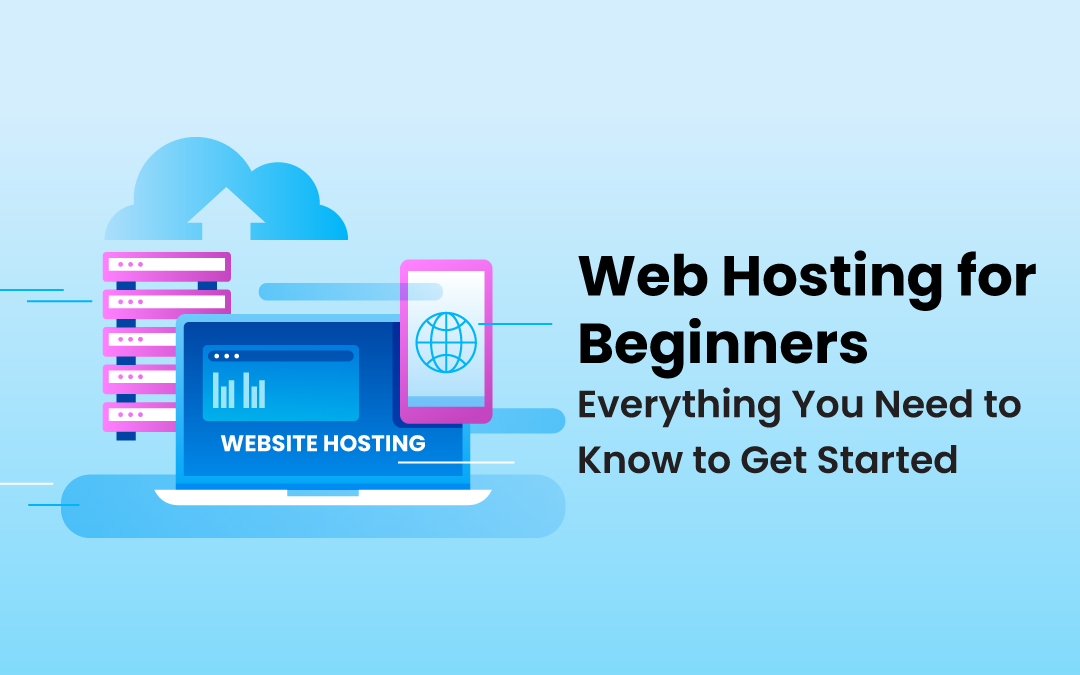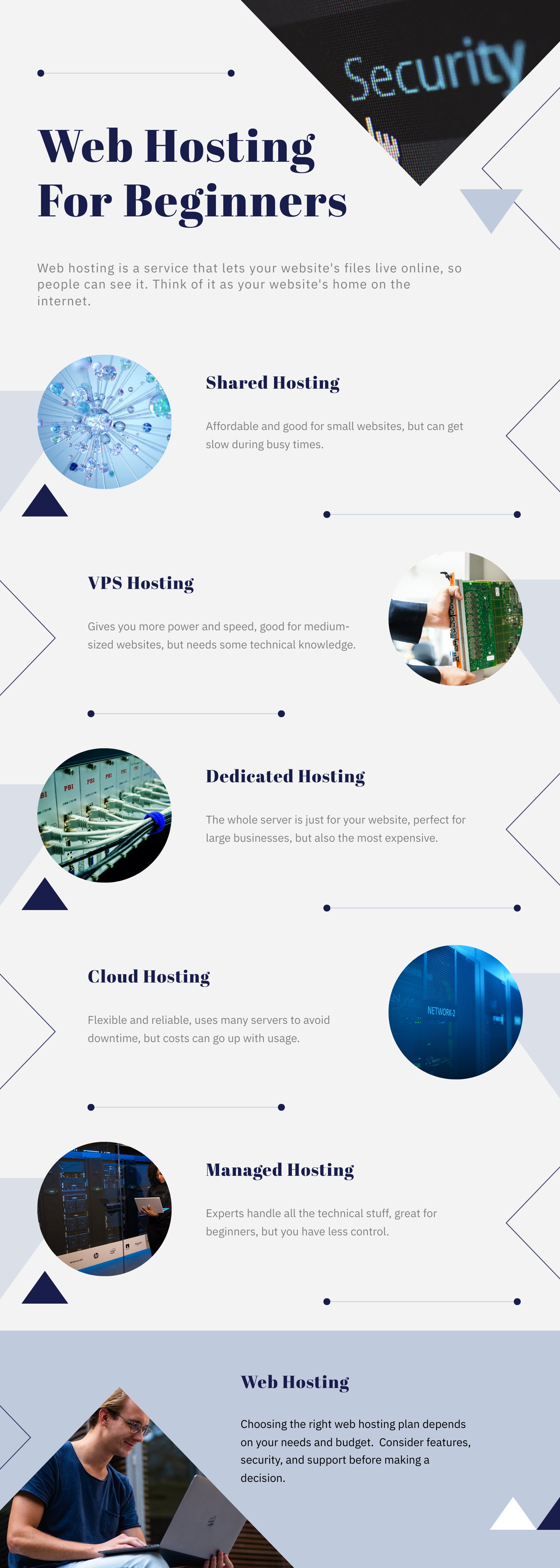
The internet has become a hub for business, communication, and creativity. Whether you’re starting a personal blog, launching an e-commerce store, or building a professional portfolio, having a website is essential in today’s digital age. However, before you can have a functioning website, you’ll need a web hosting service. For beginners, web hosting might seem like a daunting topic filled with technical jargon, but it becomes much simpler when broken down.
This guide will cover everything you need to know about web hosting, helping you take the first step toward building your online presence.
What Is Web Hosting?
Web hosting is a service that allows individuals or businesses to store their website’s files, including HTML, images, and videos, on a server that is accessible via the internet. In essence, web hosting provides the space and technology required for your website to be visible online.
When someone types your website’s address (domain name) into their browser, the browser connects to the server where your website is hosted. The server then displays your website’s content. Without web hosting, your website cannot be accessed by others.
Types of Web Hosting
Different styles of web hosting are tailored to meet various goals. Here are the most common options:
1. Shared Hosting
This is the most beginner-friendly and affordable option. With shared hosting, multiple websites share the same server and its resources, such as storage and bandwidth. It’s ideal for small websites with moderate traffic.
Pros:
- Cost-effective
- Easy to set up and manage
- Suitable for personal blogs or small business websites
Cons:
- Limited resources
- Slower performance if neighboring websites consume too much bandwidth
2. Virtual Private Server (VPS) Hosting
VPS hosting offers a middle ground between shared and dedicated hosting. While multiple websites still share a server, each website has its own allocated resources, ensuring better performance.
Pros:
- Greater control over server settings
- Scalable resources
- Improved performance compared to shared hosting
Cons:
- More expensive than shared hosting
- Requires some technical knowledge
3. Dedicated Hosting
With dedicated hosting, your website has an entire server to itself. This is best suited for large businesses or websites with high traffic.
Pros:
- Full control over server configuration
- Exceptional performance and reliability
- Enhanced security
Cons:
- High cost
- Requires technical expertise
4. Cloud Hosting
Cloud hosting uses a network of servers to host websites, ensuring high reliability and scalability. If one server encounters an issue, another server takes over, minimizing downtime.
Pros:
- Highly scalable
- Reliable performance
- Pay-as-you-go pricing model
Cons:
- Costs can add up with increased usage
- Complex setup for beginners
5. Managed Hosting
In managed hosting, the hosting company handles all technical aspects, including updates, security, and backups, making it an excellent choice for beginners or those with limited technical knowledge.
Pros:
- Hassle-free maintenance
- Optimized performance
- Enhanced security
Cons:
- Higher cost
- Limited control
Key Features to Look for in a Web Host
Choosing the right web host is critical to your website’s performance and reliability. Here are some essential features to consider:
1. Uptime Guarantee
Uptime refers to the amount of time your website remains accessible to users. A top hosting company should offer at least a 99.9% uptime guarantee to minimize downtime.
2. Speed and Performance
Website speed affects user experience and search engine rankings. Look for hosting services that provide fast loading times through solid-state drives (SSDs), content delivery networks (CDNs), and optimized servers.
3. Security
A secure hosting service protects your website from cyber threats. Look for features such as SSL certificates, regular backups, and firewall protection.
4. Scalability
As your website grows, your hosting needs may change. Choose a plan that offers scalable options, allowing you to upgrade resources as required.
5. Customer Support
Reliable customer support is essential for resolving technical issues. Look for providers offering 24/7 support through multiple channels, such as live chat, email, or phone.
How to Choose the Right Web Hosting Plan
Selecting the right web hosting plan depends on your specific needs. Here’s a step-by-step guide to help you decide:
Step 1: Determine Your Website's Purpose
Are you launching a simple blog, an online store, or a multimedia-heavy website? The complexity and purpose of your website will dictate your hosting requirements.
Step 2: Estimate Traffic Volume
For low-traffic websites, shared hosting may suffice. However, if you anticipate higher traffic, consider VPS or dedicated hosting.
Step 3: Set a Budget
While shared hosting is affordable, premium options like dedicated or managed hosting can be expensive. Choose a plan that fits your budget without compromising essential features.
Step 4: Evaluate Technical Expertise
If you’re new to website management, opt for managed hosting or a user-friendly platform with an intuitive control panel.
How to Get Started with Web Hosting
Starting with web hosting is easier than you might think. Follow these steps to get your website online:
1. Register a Domain Name
Your domain name is your website’s address (e.g., www.example.com). Most hosting providers allow you to register a domain during the signup process.
2. Choose a Hosting Provider and Plan
Compare hosting providers based on the features and pricing mentioned earlier. Once you’ve selected a provider, sign up for the plan that best suits your needs.
3. Set Up Your Website
Many hosting providers offer one-click installations for content management systems (CMS) like WordPress, making it easy to set up your website without technical expertise.
4. Upload Your Content
Add content, images, and functionality to your website using the CMS or website builder provided by your hosting provider.
5. Launch Your Website
Once you’re satisfied with your website’s design and content, publish it for the world to see.
Common Beginner Mistakes to Avoid
Starting with web hosting can involve a learning curve, but avoiding these common mistakes can save you time and frustration:
- Choosing the Cheapest Plan Without Research: While affordability is important, the cheapest plan might lack features like speed, security, or scalability.
- Ignoring Security Features: Failing to prioritize security can leave your website vulnerable to hacking and data breaches.
- Overlooking Customer Support: Technical issues can arise at any time. Ensure your hosting provider offers reliable support.
- Not Backing Up Your Website: Regular backups are essential for recovering your website in case of data loss or cyberattacks.

Conclusion
Web hosting is the backbone of your online presence, providing the infrastructure needed to make your website accessible to the world. While the process may seem overwhelming initially, understanding the types of hosting, key features, and steps to get started can make it much simpler.
By choosing a reliable hosting provider that aligns with your needs and budget, you’ll be well on your way to creating a successful website. Whether you’re building a personal blog or launching an online business, investing in the right hosting service is the first step toward achieving your digital goals.
Share this post
Leave a comment
All comments are moderated. Spammy and bot submitted comments are deleted. Please submit the comments that are helpful to others, and we'll approve your comments. A comment that includes outbound link will only be approved if the content is relevant to the topic, and has some value to our readers.

Comments (0)
No comment